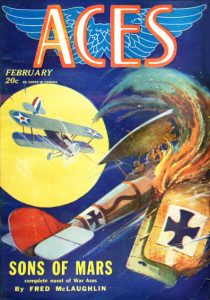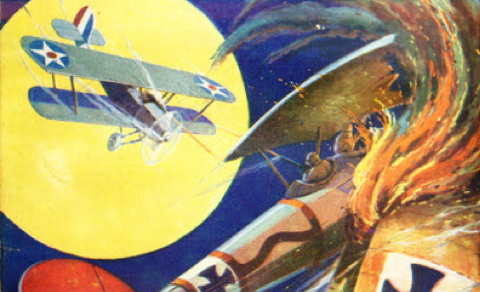 At this year’s convention, PulpFest 2018 will honor the 100th anniversary of the armistice that ended the First World War. Our programming will focus on the so-called “war pulps” of the early twentieth century and the depiction of war in popular culture. From the war pulps would sprout an even more specialized category — the air war magazine.
At this year’s convention, PulpFest 2018 will honor the 100th anniversary of the armistice that ended the First World War. Our programming will focus on the so-called “war pulps” of the early twentieth century and the depiction of war in popular culture. From the war pulps would sprout an even more specialized category — the air war magazine.
Prior to the introduction of the air war pulp, stories about fighter pilots appeared irregularly in the general fiction magazines. The majority of aviation stories prior to 1930 were unrelated to the Great War. Most air fiction of the period involved daredevil aces and barnstormers, airmail pilots and governments agents, or bootleggers and rum runners. Leading aviation author Thomson Burtis primarily wrote about the Army Air Service guarding America’s borders or tangling with criminals.
Although Fiction House would introduce the first air-oriented pulp magazine — AIR STORIES — it was Dell Publishing that melded the air with the war. The first issue of Dell’s WAR BIRDS hit the stands with its March 1928 number. It was joined about a year later by Fiction House’s ACES. Later came another Dell magazine called WAR ACES, Popular’s BATTLE ACES, BATTLE BIRDS, and DARE-DEVIL ACES, Standard’s SKY FIGHTERS and THE LONE EAGLE, and a variety of George Bruce magazines from Fiction House. The latter would also rebrand WINGS, adding “Fighting Aces of War Skies” to its title bar during the summer of 1931.
The stories in the air war magazines ranged from realistic tales “about men suffering real emotions flying real planes in real situations” to the humorous “howlers” of Phineas Pinkham and Elmer & Pokey to the science fiction versions of the First World War found in Robert J. Hogan’s G-8 AND HIS BATTLE ACES and Donald Keyhoe’s Philip Strange stories for FLYING ACES.
“The air pulps meant different things to different people. They filled the heads of all sorts with Arthurian type heroes. We needed those during the dark days of the Great Depression.”
Join PulpFest on Friday, July 27, at 8:30 PM as award-winning writer and author Don Hutchison moderates a panel on the air war magazines of the pulps. He’ll be joined by graphic designer, illustrator, and pulp premium enthusiast Chris Kalb. Aviation fiction expert Bill Mann will also be along for the flight. With Chris and David Kalb, Bill founded Age of Aces Books. Munsey Award winner and PulpFest marketing and programming director Mike Chomko will round out the panel. With Steve Young, Mike authored a portrait of WINGS for WINDY CITY PULP STORIES #18.
PulpFest 2018 will also be celebrating the 100th birthday of Philip José Farmer with FarmerCon 100. We’ll be welcoming Joe Lansdale — the author of over forty novels, numerous short stories, and more — as our Guest of Honor and hosting a rare gallery showing of original art by acclaimed writer-illustrator Mark Wheatley. Additionally, there will be author readings, a great programming line-up, two auctions featuring unique collectibles, and a dealers’ room filled with pulps, digests, and men’s adventure magazines, collectible paintings and illustrations, rare first editions, vintage paperbacks and comic books, unique films and more. PulpFest 2018 begins on Thursday, July 26, and runs through Sunday, July 29 at the DoubleTree by Hilton Hotel Pittsburgh – Cranberry.
You can join both PulpFest and FarmerCon by clicking the Register for 2018 button on the PulpFest home page. And don’t forget to book a room at the DoubleTree while you’re visiting the PulpFest site. They’re going fast!
(Fiction House was one of the leading publishers of both aviation pulps and air war magazines. The first of their titles to specialize in stories about the war in the air was ACES. Its first issue was dated December 1928. It ran for fifty-five issues, including the February 1929 number with cover art by F. R. Glass. The Spring 1940 issue was the final number of ACES.
One of the more successful air war magazines was WINGS, also published by Fiction House. Debuting with its January 1928 number, it was originally subtitled “The Magazine of Air-Adventure Stories.” It became an air war title during the summer of 1931. WINGS would run for 133 issues. Its pilots fought in both World Wars as well as the Korean War and in a variety of settings during the early days of the Cold War. The final number of WINGS was dated Summer 1953.)







